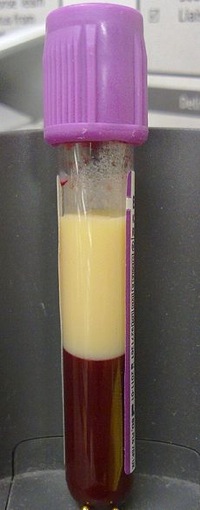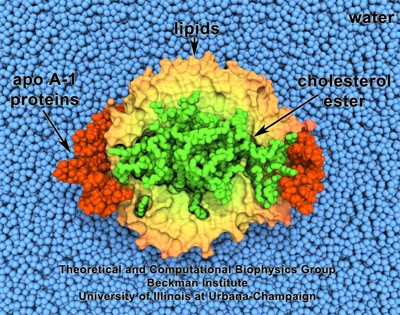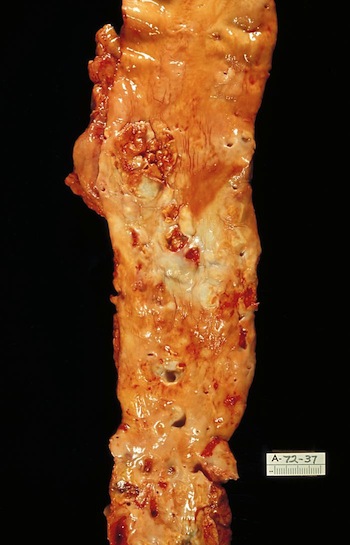
Dyslipidemia
last authored: Feb 2011, David LaPierre
last reviewed:
Introduction

blood (left for 4h) from patient with
LDL >40 mmol/L (markedly abnormal)
used with permission, Mark Shea
A typical North Americal diet includes 50-120g of fat, mainly triglycerides, daily, and of this, approximately 400-500 mg of cholesterol.
While dyslipidemia can refer to any abnormality of lipids, or fats, in the blood, it usually is associated with elevated levels of cholesterol and triglycerides. Of these, LDL, or low-density lipoprotein, appears to be the most significant in terms of risk. HDL, or high-density lipoprotein, is a protective molecule, removing harmful plaques from the vasculature.
Dyslipidemia, along with other risk factors such as smoking and hypertension, can cause atherosclerosis, or accumulation of plaques within arteries. This, in turn, can predispose for coronary artery disease and peripheral artery disease, leading to myocardial infarction, stroke, and other serious health issues.
Accordingly, lowering lipid levels in the right populations is an important goal of primary health care. It is important to understand the rationale for screening for, and treating, dyslipidemia - an inexact science that is constantly changing.
The Case of Albert G.
Albert is a 38 year-old man who comes into your office asking you to check his cholesterol, as he has been hearing a great deal about it in the news. You decide to proceed and check it, and the results come back as LDL 3.4 mmol/L, TC/HDL 4.5.
- should you have checked it?
- what, if anything, do you use to treat him?
Causes and Risk Factors
Causes of dyslipidemia that should be ruled out include:
elevated LDL
|
reduced HDL
|
high triglycerides
|
There are many genetic causes for dyslipidemias, beyond the scope of this article.
Pathophysiology

HDL. Made with VMD and owned by the Theoretical & Computational
Biophysics Group, Beckman Institute, University of Illinois,
Urbana-Champaign (more images)
main article: atherosclerosis
Most evidence examining atherosclerosis specifically implicates low density lipoprotein (LDL), the resulting 'metabolic garbage' of liver lipid metabolism. Most LDL is cleared by binding of surface apo B to LDL receptors in many tissues, especially the liver. However, it can also become lodged in vascular walls, inducing plaque development, even if other risk factors are absent.
VLDL and IDL are also involved in transporting cholesterol to the tissues.
High density lipoprotein (HDL), in contrast, is believed to mobilize cholesterol from developing and existing atheromas and transport it to the liver for excretion in the bile.
Signs and Symptoms
Dyslipidemia itself does not cause any signs or symptoms. However, a thorough history and physical exam is necessary for patients in whom it is suspected.
- history
- physical exam
History
As described below, risk factors are important for screening for, and treating, dyslipidemia.
Inquire into:
- history of coronary artery disease: angina, myocardial infarction, CABG, or PCA
- diabetes mellitus
- other vascular disease: aortic aneurysm, peripheral artery disease, stoke, TIA
family history of premature coronary disease in a first-degree relative (<55 in men, <65 in women)
cigarette smoking
alcohol intake
Investigations
- screening
- lab investigations
- diagnostic imaging
Screening
Plasma lipid profile should be screened in a number of higher-risk populations. This includes:
Canadian Cardiovascular Society (2009)
all patients with:
|
US National Cholesterol Education Program
|
Risk Assessment
There are a number of clinical calculators for calculating 10-year risk of CVD. These include:
- Framingham Risk Score (FRS) in mmol/L and in mg/dL
- Reynolds Risk Score (RRS); validated in American populations
- UKPDS risk engine (diabetes)
- Australian CVD risk calculator
There are many other risk factors associated with increased rates of CAD, though these do not appear to have an impact on treatment outcomes. Given this, however, it is wise to use clinical judgement when placing patients in risk strata. For example, consider moving patients into high-risk due to metabolic syndrome. As well, a family history of premature CAD increases risk by 1.7x in women and 2.0x in men (Genest et al, 2009). If south Asian (eg India, Pakistan)
High-Risk
|
Medium-Risk
|
Low-Risk
|
Management of Dyslipidemia
- target levels
- lifestyle modification
- medications
Target Levels
There is much debate over ideal treatment targets, though all agree risk level has a substantial impact on decision to treat. According to Canadian Guidelines, LDL is the primary target, with apoB the alternate (Genest et al, 2009). In fact, apoB may be a better marker, given its accuracy. It's target value is less than 0.8 g/L.
Cost-effectiveness of primary prevention strategies is important to consider.
Primary Targets
risk category |
initiate treatment if LDL is: (mmol/L, mg/dL) |
target LDL |
ratio total/HDL |
high (10 yr risk >20%) |
>2.0, >100 |
< 2 mmol/L, or >50% decrease |
>4 |
medium (10 yr risk 10-19%) |
>3.5, >130 |
< 2 mmol/L, or >50% decrease |
>5 |
low (10 yr risk <10%) |
>5.0, >130 with 2 or more risk factors, >160 with 0-1 risk factors |
>50% decrease
|
>6 |
Secondary Targets
trigycerides are a secondary target, after LDL.
- normal: <150 mg/dL
- borderline: 150-199 mg/dL
- high: 200-499 mg/dL
- very high >500 mg/dL
hs-CRP is another secondary target, and may be especially useful in risk stratification in men over 50 or women over 60 at intermediate risk, according to the FRS. Treatment of LDL <3.5 mmol/L appears to be beneficial if the value is >2.0 mg/L, according to Canadian guidelines and the JUPITER study (Ridker et al, 2008).
It correlates with favourable response to statin therapy. Caution should be taken, however, as CRP rises with acute illness. Two readings are therefore advisable.
Other secondary targets include:
- total cholesterol:HDL
- hs-CRP
- non-HDL cholesterol (total cholesterol - HDL cholesterol)
- apoB to apoAI ratio
Clinical evidence is viewed by many to be lacking in regards to these secondary targets.
HDL should be >40 mg/dL.
If dyslipidemia is found, screen for secondary causes, including
An expert should be consulted if you suspect an underlying disorder due to the following: positive family history for genetic conditions, very low HDL, or very high triglycerides. Referral may also be considered in cases of drug intolerance, lack of response, or unexplained atherosclerosis.
Consequences and Course
As discussed, the primary concern for patients with dyslipidemia is cardiovascular disease through atherosclerosis, including coronary artery disease and myocardial infarction, stroke, and peripheral artery disease.
Hypertriglyceridemia can cause acute pancreatitis.
Resources and References
Baigent C et al. 2005. Efficacy and safety of cholesterol-lowering treatment: prospective meta-analysis of data from 90,056 participants in 14 randomised trials of statins. Lancet. 366:1267-78.
Genest J et al. 2009. 2009 Canadian Cardiovascular Society/Canadian guidelines for the diagnosis and treatment of dyslipidemia and prevention of cardiovascular disease in the adult - 2009 recommendations. Can J Cardiol. 25(10):567-79.
Lichtman JH et al. 2008. Depression and coronary heart disease: recommendations for screening, referral, and treatment: a science advisory from the American Heart Association Prevention Committee of the Council on Cardiovascular Nursing, Council on Clinical Cardiology, Council on Epidemiology and Prevention, and Interdisciplinary Council on Quality of Care and Outcomes Research: endorsed by the American Psychiatric Association. Circulation. 118(17):1768-75.
McPherson R et al. 2006. Canadian Cardiovascular Society position statement--recommendations for the diagnosis and treatment of dyslipidemia and prevention of cardiovascular disease. Canadian Journal of Cardiology. 22(11):913-27.
Topic Development
authors: David LaPierre, 2011
reviewers:

